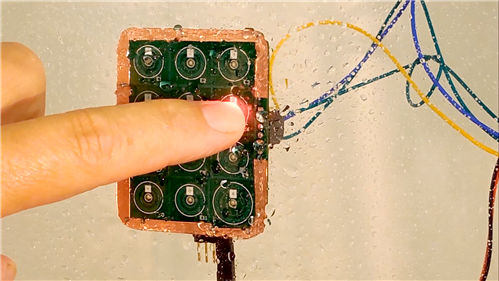SSZTAK8 november 2016 MSP430FR2532 , MSP430FR2533 , MSP430FR2632 , MSP430FR2633
Capacitive touch panels can be touchy, especially in the rain when a drop of water can look a lot like a fingertip and the swipe of a drying towel can drive lesser microcontrollers (MCUs) crazy.
The problem can be particularly troublesome for applications like electronic locks (e-locks) or an outdoor security panel that might, for example, open and close gates around an apartment complex. In addition to rain, such applications are subject to other harsh conditions like high temperatures and humidity. In some regions, insects and animals like geckos can trigger false touches. And certain installations are sometimes plagued by electrical noise from close by motors.

About a year ago, a new capacitive touch front end was integrated into the MSP430™ FRAM MCUs, creating a one-chip solution for a wide range of capacitive touch applications. These new MCUs integrate CapTIvate™ touch technology which is ultra-discriminating, so much so that it can sense through a driving rain storm to eliminate false readings. After all, no one wants to stand outside in the rain while the security lock malfunctions.
The heightened sensitivity of CapTIvate touch technology means that system designers can seal the touch panel, electrode sensors and other electronics behind thick glass, translucent plastic or even metal to keep the moisture out and yet still distinguish the difference between a drop of water and an actual finger touch. CapTIvate technology is so sensitive it can measure changes in capacitance as small as 10 femto-Farads while sensing a wide dynamic range of capacitance of up to 300 pico-Farads. Touches can be sensed through glass overlays of 60 mm and plastic up to 25 mm thick. It also features a special guard channel that is able to detect and adjust for changing environmental conditions like rain. A library of touch software modules makes it easy for developers to fine tune their systems to the expected environmental conditions of an application and its locale.
Capacitive Touch Keypad in Rain with CapTIvate Technology
Of course, some of these applications, such as e-locks, will be battery-operated, which means low-power consumption is a must. And others, like a security panel close to a motor-driven gate, could be susceptible to electrical noise from power lines or the motor. In both such cases, CapTIvate technology is up to the challenge. MCUs with CapTIvate technology, such as the MSP430FR2633 device, consume as little as one-tenth of the battery power of comparable MCUs, extending the life of a coin cell battery by at least 30 percent. And a memory architecture based on ferroelectric random access memory (FRAM) gives designers plenty of space for data logging, such as the entry codes that were used to open a door or gate. FRAM also gives designers greater flexibility since the developer can configure how much space is devoted to program storage and how much to data storage.
As for electrical noise or cross-talk noise from long traces, this capacitive touch technology features a very robust integrator-based charge transfer method for measuring capacitance. Plus, an independent oscillator lets the CapTIvate touch subsystem perform oversampling and frequency hopping to increase the reliability of its measurements. And, because of a 1.5 V low-dropout regulator, the capacitive sensors can be driven at 1.5 V instead of a higher voltage, reducing the electrical noise emissions when compared with other such MCUs. With flying colors, MSP430 MCUs with CapTIvate technology pass all of the requirements of electromagnetic compatibility standards like IEC6100-4-4, IEC6100-4-6 and IEC6100-4-2.
So don’t let a little thing like a few drops of water rain on your touch panel parade. Check out CapTIvate technology on MSP430 MCUs at MSP430™ FRAM microcontrollers with CapTIvate™ technology.
Additional Resources:
- Download our MSP430FR2633 Microcontroller CapTIvate Electronic Lock and Keypad Reference Design (TIDM-CAPTIVATE-E-LOCK)
- Get started with the MSP430 CapTIvate MCU Development Kit
- Learn more about CapTIvate™ MCUs in this CapTIvate™ Technology Guide